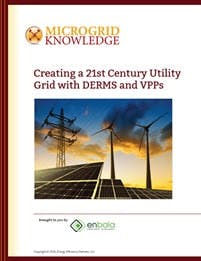Last week, the new Microgrid Knowledge Special Report series that explores the benefits of distributed energy management systems (DERMS) and virtual power plants (VPPs) covered how VPPs can replace conventional power plants while also providing higher efficiency, greater flexibility and increased grid reliability. Here’s the third post, that focuses on why DERMS are essential to today’s new generation of grid control and optimization.
Download the full report.
DERMS are state-of-the-art systems that seamlessly integrate high penetrations of solar energy and other distributed energy resources into the grid. When properly deployed, their capabilities provide multiple benefits to both utilities and their customers, a win-win.
Consisting of a suite of software management tools that allow distribution utilities and wire operators to manage an array of DERs, they offer near real-time control of grid assets.
Navigant Research defines DERMS as “a control system that enables optimized control of the grid and DERs, including capabilities such as Volt/ VAR optimization (VVO), power quality management and the coordination of DER dispatch to support operational needs.”
DERMS-controlled grid services are delivered by manipulating power and voltage along individual feeders, giving the utility precise control of a wide range of equipment, including smart inverters, capacitor banks, on-load tap changers, voltage regulators (VRegs) and customer loads.
DERMS use a real-time communications infrastructure to monitor, control, coordinate and manage distributed energy assets connected to the utility at the local level. DERMS-controlled grid services are delivered by manipulating power and voltage along individual feeders, giving the utility precise control of a wide range of equipment, including smart inverters, capacitor banks, on-load tap changers, voltage regulators (VRegs) and customer loads. This contrasts with VPPs, which also control the active power contributions of DERs but at a broader, system-wide level. VPPs are used to provide grid services such as demand response, frequency regulation and operational reserves. These are services that require increased or decreased generation or load, rather than precise, local-level control.
Managing grid events locally
“Because a DERMS knows exactly where every asset is located on the distribution system, it can precisely target specific assets of the distribution system,” says Eric Young, vice president, industry solutions for Enbala.
“For example,” he continues, “this allows the DERMS to control devices down-line of specified transformers or measured points on feeder lines so that when a utility experiences challenges with too many renewables coming online, the system knows exactly which assets to control to mitigate associated problems.”
These assets might include smart inverters or more traditional utility control equipment. This location-driven focus allows the DERMS to exercise a high degree of control over both real power (watts), voltage and reactive power (VARs). Operators can increase load on one part of a feeder while decreasing load (or increasing distributed supply) on another part of the same feeder. Utilizing DERMS, utilities and wire operators can also bias the reactive power of DERs to manage voltage or regulate distribution feeder voltage profiles.
DERMS reap advantages by teaming up with devices such as smart inverters to protect the grid feeder systems. For example, too much solar on the grid can cause voltage problems. To address this challenge, DERMS can sense this is happening and control real-time voltage signatures and power flows on a distribution feeder to regulate grid conditions, preventing voltage excursions, brownouts and power outages. DERMS can dynamically control a variety of settings on smart inverters, which optimize the voltage and phase angle at the inverter’s terminals, resulting in better line voltage regulation and decreased technical losses throughout the distribution system.
Greater grid flexibility and resiliency
The ability of DERMS to manage large numbers of distributed assets can lead to a more flexible and resilient grid. This is especially important as more renewable energy sources come online. For example, voltage fluctuations that result from the high variability of PV can be effectively dealt with by optimizing DERs, including client loads, on the grid.
DERMS balance the grid by using advanced optimization algorithms that can compute the most efficient usage of each grid asset. To do this, DERMS utilize data obtained from DERMS-enabled devices, smart metering infrastructure and other distribution grid sensors. By sending control signals, DERMS will adjust, turn on or off the devices connected to the DERMS network, including behind-the-meter resources, such as on-site generators and batteries. The systems can even efficiently regulate client assets. These might be chillers, fans, lights or other assets able to both cut costs for the customer and optimize the operation of the entire distribution network.
In conjunction with a distributed management system, DERMS will automatically control all the devices along a feeder line, including customer loads and utility equipment, to achieve this goal for peak energy savings.
The DERMS platform can monitor and control tens of thousands of devices, including battery storage, PV and utility control equipment in order to support the power requirements of the grid. For example, to support volt/VAR control, a utility only needs to request a nominal voltage/VAR flow along a feeder. In conjunction with a distributed management system, DERMS will automatically control all the devices along a feeder line, including customer loads and utility equipment, to achieve this goal for peak energy savings.
“Let’s say the utility operator needs to urgently relieve congestion on a key part of the distribution system,” says Young. “The DERMS will assess the capability of each controllable device on the line, taking into consideration the operational constraints and requirements that have been specified by the asset owner to identify the best solution to alleviate that specific point of congestion.”
“It is important to note that these constraints can include limits on heating, air conditioning and hot water temperature changes for loads, cycling requirements of batteries and other assets, as well as technical and economic limits of other distributed options, to name a few,” he adds.
All of this is completely transparent to clients, who will not notice the control exerted over their devices. It’s also transparent to the utility; DERMS aggregate the responses from all the devices so that the utility sees only a single dispatchable resource moving automatically based on grid conditions.
While a VPP is a specialized system that enables always-on, highly scalable, cost optimized, secure and automated services into a wholesale market product for regulation or capacity, DERMS allow medium and low voltage utility-operators to utilize DERs and IoT technology within their very local paradigm to drive optimization capabilities that simply cannot scale to even the most modern advanced distribution management systems.
Regulatory challenges to DERMS
DERMS are highly scalable systems that will be employed by a utility to control DER assets coupled to their distribution systems. The assets under DERMS control can be utility owned, supplier owned or privately owned. If the assets are not owned by the managing entity, then compensation may need to be provided to the owner. Under current systems, the amount and method of compensation is not yet being set by a market product, which leaves an ad-hoc process, if any, to ensure the usage of these assets when called upon.
In the near future, several regulatory challenges that currently hinder the widespread usage of DERMS are likely to be resolved. For example, today no established markets or pricing mechanisms exist for reactive power at the distribution level, so no means exist to compensate the owners of the assets. Additionally, some states do not allow distribution utilities to have any control over power generation or power export capable systems such as batteries or privately owned solar and wind turbines. This prevents utilities from taking advantage of the full capabilities contained within DERMS.
In addition to regulatory obstacles, there are also technical challenges facing the implementation of DERMS by utilities and grid operators. For example, to unlock all the benefits of DERMS, a fairly accurate representation of the distribution system is required, including how and where loads and DERs are connected. In addition, a method to supply more sophisticated telemetry may be required that can quickly inform the software of problems or issues with the grid. So, to properly implement DERMS within their distribution networks, utilities may need to make new infrastructure investments, mostly in sensing but also perhaps other equipment. In the simplest case, utilities can employ a less detailed grid representation, which would allow them to implement VPPs now. This would also enable DERMS deployment as other projects drive the creation of a phase-representative grid model (and supporting systems) to ensure it stays in sync with the actual grid.
Going green with DERMS
The same fundamental technology that allows us to order a ride via smart phone — from where we are to where we need to go — can be leveraged to build a more efficient, reliable and resilient electrical grid. Utilities, regulatory agencies, and grid operators can embrace wireless communications, cellular, and technologies such as distributed energy management systems to overcome the inefficiencies of today’s power grid.
“With DERMS and other resources in action, the nextgeneration grid will be able to seamlessly support magnitudes greater renewable and distributed energy sources, while harnessing the unnoticed flexibility in the demand side of the system,” says Young. “This will enable not only a cleaner, but a sustainable energy future.”
The Microgrid Knowledge Special Report series will also cover the following topics over the coming weeks:
- The 21st Century Power Grid: Not Your Parents’ Power Grid
- Virtual Power Plants: Coming Soon to a Grid Near You
- How DERMS and Smart Inverters Safely Bring Distributed Resources to the Grid
- Smoothing the Path for DER Orchestration: New Rules for a New World
- Blazing the Path from Virtual Power Plants to Holistic Grid Control with DERMS
Download the full report, “Creating a 21st Century Utility Grid with DERMS and VPPs,” courtesy of Enbala, to learn more about how these tools and more are changing the face of the 21st century power grid.







